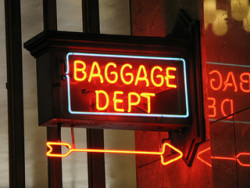
Backstory is such a juicy element of story, it’s too bad it’s got such a bad rap. Sure, it can fill a plot hole, juice up a reveal, give us an “aha!” moment. Think of Faye Dunaway in Chinatown, “She’s my daughter, she’s my sister, she’s my daughter and my sister.” A single line of dialogue that changes everything. A great backstory, including that one, presents us with the heart of the matter.
We know that having a big opening can grab our reader’s attention. Sustaining that attention through a whole book requires sympathetic characters. On a less conscious level, we like characters who are just plain messed up, particularly if they are messed up in the same way that we—the readers, viewers, audience—are messed up. Our heroine always has a broken heart, a failed career, some bit of baggage that we know is just like the bit of baggage we, the audience members, carry with us. We’re lucky. We get to avoid the frightening task of fighting our demons because a fictional being, our heroine, comes along to fight those same demons. That is identification. We clueless audience members, get to read with glee while she faces obstacles diabolically chosen by the writer to challenge every part of her, and we hope, oh how we hope, that she will defeat her demons and reign victorious. Her victory is our victory.
If the backstory is only what happened before the story starts, it deserves the bad rap. Great backstory is the very heart of the matter: the broken pieces of the heroine’s past that puts that particular character in that particular fix, with those particular obstacles, at that particular time, so she can heal her wounds and help us heal our own. It is the reason the writer writes that specific story and the reader is reading it, whether either knows it or not.
Sound too mushy for you?
Well, here’s the big reveal. It’s not mush.
It’s neuroscience.
Yeah, really.
